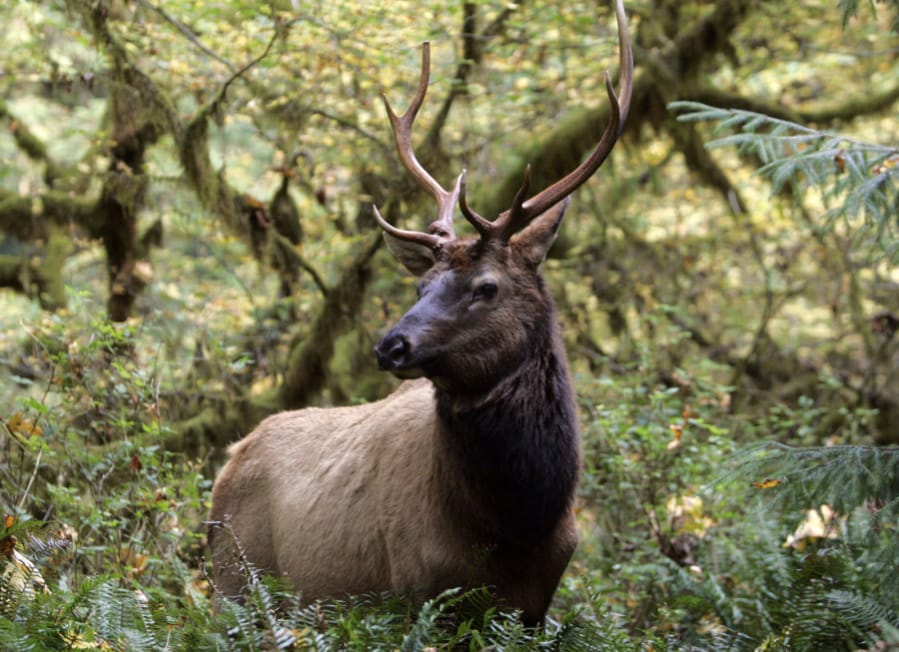When rifle hunters will head into the woods in search of elk in Southwest Washington next month, they will find the herds to be in about the same condition as they were in 2019.
The Willapa Hills herd is still strong, but the Mount S.t Helens herd is struggling with hoof disease, and their numbers remain low.
Eric Holman, a Washington Department of Fish and Wildlife biologist for the state’s Region 5, reports that the COVID-19 pandemic affected the WDFW’s ability to conduct their spring elk surveys.
“We were able to get out and do the coastal surveys just before the COVID restrictions came down,” Holman said.
They were able to cover the Game Management Units (GMAs) 506, 530, 658 and 681.
“Those were good,” Holman said. “Calf ratios were solid, and the bull-to-cow ratios were meeting our management objectives. Those elk seem to be doing very well these days. The harvest has been stable, and we even saw a (harvest) upswing.”
He noted that the elk hoof disease does not seem to be as prevalent here as it is in the herds to the east of Interstate 5.
The bad news is that the other main herd in Southwest Washington still seems to be struggling to recover, although the department was unable to conduct spring surveys in those GMUs. Restrictions came down before those surveys could be conducted. Holman did not expect any major shifts to come out of those surveys.
“They’ve just been continuing down a long-term decline since about 2010,” he said. “The population is about a third of what it was in the mid-2000’s. There are still elk out there. Hunters are still harvesting hundreds of elk, but I did not expect them to jump up a whole bunch in one year.”
The herd has been negatively impacted by Treponema-Associated Hoof Disease (TAHD). The bacterial infection causes deformities in the hooves of elk, and eventually leaves them lame.
The WDFW is still working on plans to incentivize hunters to remove as many infected animals as they can to help slow the spread of the disease. WDFW wants to be able to offer a good chance at quality elk tags for those hunters that harvest an animal with signs of TAHD. Holman suggests that hunters can help slow the disease by removing an infected animal.
“We are hopeful that the elk that are vulnerable to hoof disease get thinned out of the population,” he said.
Dr. Margaret Wild, an expert in veterinary microbiology and pathology for Washington State University and the lead in the state’s research into TAHD, said their work was unfortunately disrupted by the pandemic.
She explained that they had to halt captive animal studies because the large crews needed to collect live elk meant putting too many people in close proximity to each other, and they did not want to endanger volunteers, staff, and students.
“It all just adds up and is more risk than we are willing to put staff under, in particular our students,” she said. “But this week we are scheduled to start our first experiment.”
That will involve seeing if elk can acquire the disease from bacteria in soils, instead of direct animal-to-animal infection.
She did report that they now have more evidence in hand to support that the disease is, in fact, caused by a bacterial infection.
Unfortunately, it will still be some time before there can be any kind of effective action that can be taken to mitigate the spread and prevalence of the disease in wild herds of elk. The scientists need data on how the disease spreads, what environmental factors come into play to aid the spread, and what effects the condition of the animal has on infection rates.
Wild asks that hunters that see limping elk or animals that have hoof lesions report it to the WDFW, and if they harvest an infected animal, they can contact the department via the toll-free wildlife health lab number at 866-968-2600, or email veterinarians at Wildlife.Health@state.or.us to arrange collection of the diseased hooves.
Elk hunters in Region 5 are also struggling with a lack of access. Without free access to the extensive Weyerhaeuser tree farms, which are now pay-for-access, most hunters are left with a patchwork of lands that include National Forest, Bureau of Land Management properties, Washington Department of Natural Resources lands, and state wildlife areas.
One of those wildlife areas is the 14,200-acre Cowlitz Wildlife Area near Randle. Richard Vanderlip manages the area for the WDFW, and he said that the lands do attract some elk.
“We do have elk and we do have people that hunt them,” said Vanderlip. “Probably the Peterman Unit is one that sees the most pressure from elk hunters, and it is our largest unit at about 600 acres. We also have elk in the (Cowlitz Valley) in the Davis Lake Unit.”
Vanderlip knows that hunters do harvest elk in the wildlife area, and he talked to several muzzleloader hunters that were successful earlier this fall. However, he warns that, like elsewhere, taking a bull is hit or miss.
Most of the GMU’s in western Washington restrict hunters to taking a bull that has three antler points or better, but a few units allow for other animals to be harvested, so check the regulations before you hunt.
For more information, check the WDFW Hunting Prospects webpage at: https://wdfw.wa.gov/hunting/locations/prospects
Southwest Washington weekly Fishing Report and Forecast: For an accurate and thorough southwest Washington fishing report and forecast by Terry Otto, go to Bob Rees’ “The Guides Forecast” at https://www.theguidesforecast.com/



